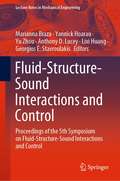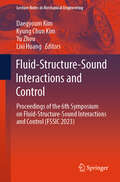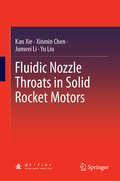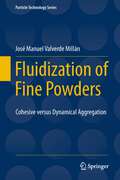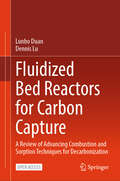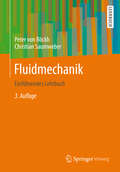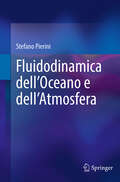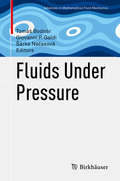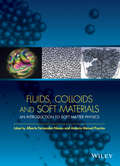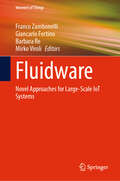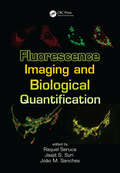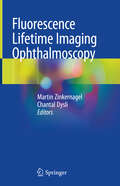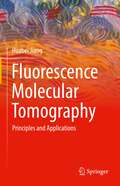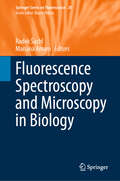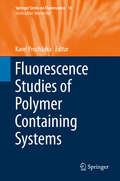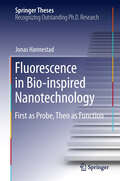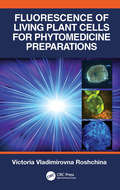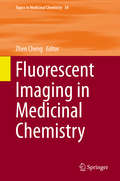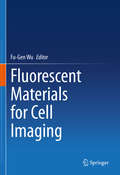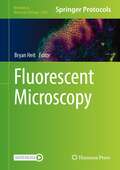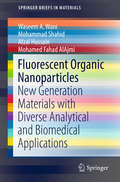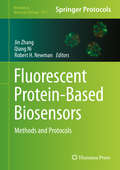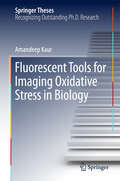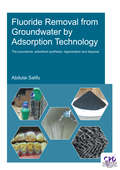- Table View
- List View
Fluid-Structure-Sound Interactions and Control: Proceedings of the 5th Symposium on Fluid-Structure-Sound Interactions and Control (Lecture Notes in Mechanical Engineering)
by Marianna Braza Yu Zhou Lixi Huang Yannick Hoarau Georgios E. Stavroulakis Anthony D. LuceyThis book contains a thorough and unique record of recent advances in the important scientific fields fluid–structure interaction, acoustics and control of priority interest in the academic community and also in an industrial context regarding new engineering designs. It updates advances in these fields by presenting state-of-the-art developments and achievements since the previous Book published by Springer in 2018 after the 4th FSSIC Symposium. This book is unique within the related literature investigating advances in these fields because it addresses them in a complementary way and thereby enhances cross-fertilization between them, whereas other books treat these fields separately.
Fluid-Structure-Sound Interactions and Control: Proceedings of the 6th Symposium on Fluid-Structure-Sound Interactions and Control (FSSIC 2023) (Lecture Notes in Mechanical Engineering)
by Yu Zhou Lixi Huang Daegyoum Kim Kyung Chun KimThis proceedings book focuses on advances in theory, experiments and numerical simulations of fluid-structure-sound interactions related to turbulence, flow-induced vibration, noise and their control. This includes important practical areas of interaction such as vehicle aerodynamics, marine and civil engineering, nuclear reactors and biomedicine. One of the special features of this book is that it integrates new emerging fields with the study of fluid-structure-sound interactions, which is not common practice but scientifically very helpful in understanding, simulating and controlling fluid-structure-sound interaction systems. This provides a broader view of the discipline from which readers will benefit greatly.
Fluidic Nozzle Throats in Solid Rocket Motors
by Yu Liu Kan Xie Xinmin Chen Junwei LiThis book focuses on the performance and application of fluidic nozzle throats for solid rocket motors, discussing their flow details and characterization performance, as well as the influence of the particle phase on their performance. It comprehensively covers a range of fluidic nozzle throats in solid rocket motors and is richly illustrated with impressive figures and full-color photographs. It is a valuable resource for students and researchers in the fields of aeronautics, astronautics and related industries wishing to understand the fundamentals and theories of fluidic nozzle throats and engage in fluidic nozzle throat analysis and design.
Fluidization of Fine Powders
by José Manuel Valverde MillánThis book covers the rich phenomenology exhibited by fine powders when they are fluidized by a gas flow. Fine powder cohesiveness leads to poor flowability, clumping, difficulty in fluidizing, irregular avalanching behavior, etc. Despite all the inconveniences, fine powder processes pervade the chemical, pharmaceutical, agricultural and mining industries among others. The author in this book analyzes the mechanism by which interparticle adhesive forces are reduced by means of surface additives. Different techniques have been developed in the last years to assist fluidization by helping the gas flow to mobilize and break cohesive aggregates, which help to homogenize fluidization. As reviewed in this book, the use of these techniques may have a relevant impact on novel processes based on fluidized beds of fine powder and with relevant applications on leading edge technologies such as Atomic Layer Deposition on nanoparticles and CO2 capture by gas-fluidized beds of adsorbent powders. The study of fluidized beds has a marked interdisciplinary character. This book is thus intended for academic and industrial researchers in applied physics, mechanical, chemical, and environmental engineering, who are interested in the special characteristics of fine powders.
Fluidized Bed Reactors for Carbon Capture: A Review of Advancing Combustion and Sorption Techniques for Decarbonization
by Lunbo Duan Dennis LuThis open access book provides a perspective on CO2 capture technologies that employ fluidized bed rectors, (FBRs) involving pre-combustion gasification, oxy-fuel combustion, chemical looping combustion, calcium looping process, and low-temperature sorption. The state-of-the-art progress from the lab-scale FBRs to pilot-scale demonstration facilities is summarized, and the remaining challenges are discussed. Moreover, this book also discussed the future solutions to overcome existing barriers in the application of FBRs for CO2 capture and provided an outlook on potential advancements and improvements. The authors anticipate endeavors made herein can impel the commercialization of fluidized bed technologies for CO2 capture from large industrial sources.
Fluidmechanik: Einführendes Lehrbuch
by Christian Saumweber Peter Von BöckhDieses Lehrbuch liegt jetzt in der 3. Auflage vor. Es behandelt u.a. - die wichtige Berechnung des Druckverlustes bei der Strömung von Flüssigkeits-/Gasgemischen in Rohren - die kritische Strömung von Gasen und Flüssigkeits-/Gasgemischen - die Strömung kompressibler Fluide mit hoher Geschwindigkeit (Fanno-Linie) - Reibungsdruckverluste in quer angeströmten Rohrbündeln - Grundlagen der numerischen Lösungsmethoden - Strömungsmesstechnik und Fehlerrechnung - in Mathcad erstellte Beispiele, die im Internet abgerufen werden können. Die Studierenden lernen, mit Hilfe des Buches anspruchsvolle Apparate, wie z.B. Raketenbrennkammer, Verdampfer oder Kondensatoren für Wärmepumpen, selbständig auszulegen. Der Aufbau des Buches zeichnet sich durch eine praxisnahe, klar strukturierte und systematische Darstellung aus. Zahlreiche durchgerechnete Beispiele erleichtern das Verständnis. Die Zielgruppen Studierende des Maschinenbaus und der Verfahrenstechnik an Universitäten und Fachhochschulen
Fluidodinamica dell’Oceano e dell’Atmosfera
by Stefano PieriniQuesto testo esplora la Fluidodinamica dell'Oceano e dell'Atmosfera ed è concepito specificamente per corsi di laurea di primo livello (B.Sc., livello upper undergraduate). Sebbene la fluidodinamica sia ampiamente trattata in vari corsi di Ingegneria - come l’Ingegneria Meccanica, Civile, Idraulica, Navale e Aerospaziale - esiste una carenza di testi universitari che affrontino l'argomento con un approccio più aderente alla Fisica e che includano specifici aspetti riguardanti l’oceano e l’atmosfera. Questo libro nasce con l’obiettivo di colmare tale lacuna. Nella prima parte, dopo un'introduzione ai fondamenti della fluidodinamica incompressibile - evitando di soffermarsi su aspetti di interesse puramente ingegneristico - viene trattato in dettaglio un tema di grande rilevanza meteo-oceanografica: le onde di gravità, sia superficiali sia interne. La seconda parte è interamente dedicata alla fluidodinamica in sistemi di riferimento rotanti, con un focus sugli aspetti basilari della meteorologia e dell’oceanografia dinamica, nei quali la forza apparente di Coriolis gioca un ruolo cruciale. Questo testo si propone come una preziosa risorsa per studenti e ricercatori che desiderino acquisire le basi della fluidodinamica applicata a contesti oceanici e atmosferici, offrendo una prospettiva fisica dettagliata e rigorosa.
Fluids Under Pressure (Advances in Mathematical Fluid Mechanics)
by Giovanni P. Galdi Tomáš Bodnár Šárka NečasováThis contributed volume is based on talks given at the August 2016 summer school “Fluids Under Pressure,” held in Prague as part of the “Prague-Sum” series. Written by experts in their respective fields, chapters explore the complex role that pressure plays in physics, mathematical modeling, and fluid flow analysis. Specific topics covered include:Oceanic and atmospheric dynamicsIncompressible flowsViscous compressible flowsWell-posedness of the Navier-Stokes equationsWeak solutions to the Navier-Stokes equationsFluids Under Pressure will be a valuable resource for graduate students and researchers studying fluid flow dynamics.
Fluids, Colloids and Soft Materials: An Introduction to Soft Matter Physics
by Alberto Fernandez-Nieves Antonio Manuel PuertasThis book presents a compilation of self-contained chapters covering a wide range of topics within the broad field of soft condensed matter. Each chapter starts with basic definitions to bring the reader up-to-date on the topic at hand, describing how to use fluid flows to generate soft materials of high value either for applications or for basic research. Coverage includes topics related to colloidal suspensions and soft materials and how they differ in behavior, along with a roadmap for researchers on how to use soft materials to study relevant physics questions related to geometrical frustration.
Fluidware: Novel Approaches for Large-Scale IoT Systems (Internet of Things)
by Giancarlo Fortino Franco Zambonelli Mirko Viroli Barbara ReThis book provides an overview of the many approaches that can adopted for programming and deploying highly-adaptive and large-scale IoT systems, with a specific focus on the key results achieved within the Fluidware research project. The authors start by presenting Fluidware, which develops a novel programming model for IoT services and applications, along with the associated and robust large-scale IoT services and applications. Starting from previous findings in the areas of field-based coordination, collective adaptive systems, stream computing and aggregate computing, the authors address the complexity of building modern, large-scale IoT systems, by a full-fledged engineering approach revolving around a new notion of distributed programming. The authors show how the key innovative idea of Fluidware is to abstract collectives of devices of the IoT fabric as sources, digesters, and targets of distributed "flows" of contextualized events, carrying information about data produced and actuating commands. The book is divided into three parts: (i) the first part is a general introduction to the Fluidware ideas and to the key problems associated with programming IoT systems, (ii) the second part presents the key results achieved within the Fluidware project; (iii) the third part identified open challenges and research directions.
Fluorescence Imaging and Biological Quantification
by Jasjit Suri Raquel Seruca J. SanchesThis comprehensive reference work details the latest developments in fluorescence imaging and related biological quantification. It explores the most recent techniques in this imaging technology through the utilization and incorporation of quantification analysis which makes this book unique. It also covers super resolution microscopy with the introduction of 3D imaging and high resolution fluorescence. Many of the chapter authors are world class experts in this medical imaging technology.
Fluorescence Lifetime Imaging Ophthalmoscopy
by Martin Zinkernagel Chantal DysliThis book focuses on the emerging non-invasive imaging technique of Fluorescence Lifetime Imaging Ophthalmoscopy (FLIO). FLIO reveals unique information on retinal diseases, ranging from age-related macular degeneration and vascular diseases to hereditary retinal dystrophies. Fluorescence lifetimes enable the evaluation of disease progression before irreversible structural changes occur. The image acquisition is suitable for diagnostic purposes and follow-up examinations to investigate the natural course of disease, and to monitor the effects of possible therapies. This book fills the gap between available literature and gives state-of-the-art guidance on the principles of the FLIO technique, image acquisition, and data analysis. Written by a team of expert leaders within this field, this book will be relevant for scientists and clinicians with an interest in ophthalmoscopy.
Fluorescence Lifetime Spectroscopy and Imaging: Principles and Applications in Biomedical Diagnostics
by Laura Marcu Paul M. W. French Daniel S. ElsonDuring the past two decades, there has been an increasing appreciation of the significant value that lifetime-based techniques can add to biomedical studies and applications of fluorescence. Bringing together perspectives of different research communities, Fluorescence Lifetime Spectroscopy and Imaging: Principles and Applications in Biomedical Dia
Fluorescence Molecular Tomography: Principles and Applications
by Huabei JiangFluorescence Molecular Tomography: Principles and Applications is the first book to cover the underlying principles and practical applications of fluorescence molecular tomography (FMT) in a systematic manner. Using a tutorial approach, the text begins with an overview of the fundamentals of FMT and goes on to detail image reconstruction approaches (including linear and nonlinear reconstruction algorithms), FMT instrumentations (including time-domain, frequency-domain, and continuous-wave domain systems), and implementation of image-enhancing schemes (including both software and hardware approaches). Further chapters examine multimodal approaches combining photoacoustic tomography (PAT), computed tomography (CT), single-photon emission tomography (SPECT), and magnetic resonance imaging (MRI) and discuss bioluminescence tomography and miniaturized FMT from hand-held to endoscopic FMT. A final chapter looks at clinical applications and animal studies. This authoritative and practical guide will serve as a valuable reference for researchers, scientists, clinicians, and industry professionals.The first book dedicated to fluorescence molecular tomography (FMT); Covers underlying principles and practical applications; Written by a leading FMT research pioneer and expert.
Fluorescence Spectroscopy and Microscopy in Biology (Springer Series on Fluorescence #20)
by Radek Šachl Mariana AmaroThis book provides the reader with an updated comprehensive view of the rapidly developing and fascinating field of fluorescence spectroscopy and microscopy. In recent years, fluorescence spectroscopy and microscopy have experienced rapid technological development, which has enabled the detection and monitoring of single molecules with high spatial and temporal resolution. Thanks to these developments, fluorescence has become an even more popular method in physical, biological and related fields. This book guides the reader through both basic and advanced fluorescence spectroscopy and microscopy approaches with a focus on their applications in membrane and protein biophysics. Each of the four parts: A - Fluorescence Spectroscopy, B - Fluorescence Microscopy, C - Applications of Fluorescence Spectroscopy and Microscopy to biological membranes and D - Applications of Fluorescence Spectroscopy to protein studies are written by experts within the field. The book is intended for both complete beginners who want to quickly orient themselves in the large number of existing fluorescent methods, as well as for advanced readers who are interested in particular methods and their proper use.
Fluorescence Studies of Polymer Containing Systems
by Karel ProcházkaThis volume describes the application of fluorescencespectroscopy in polymer research. The first chapters outline the basicprinciples of the conformational and dynamic behavior of polymers and reviewthe problems of polymer self-assembly. Subsequent chapters introduce the theoreticalprinciples of advanced fluorescence methods and typical examples of theirapplication in polymer science. The book closes with several reviews of variousfluorescence applications for studying specific aspects of polymer-solution behavior. It is a useful resource for polymerscientists and experts in fluorescence spectroscopy alike, facilitating theircommunication and cooperation.
Fluorescence in Bio-inspired Nanotechnology: First as Probe, Then as Function
by Jonas HannestadIn his thesis Fluorescence in Bio-inspired Nanotechnology, Jonas Hannestad describes the evolving field of DNA nanotechnology in a lucid and easily accessible way. A central theme in the thesis is how biological structures and mechanisms constitute a basis for the design of novel technologies. Hannestad discusses how self-assembled, nanometer-scale DNA constructs can be functionalized using fluorescent labeling. In particular, he highlights how applications are based on fluorescence resonance energy transfer (FRET). Another important contribution is the development of a lipid monolayer platform for the step-by-step assembly of DNA nanoconstructs. The work in the thesis is based on five peer-reviewed papers published in high-profile journals, all of which involve major contributions from the author.
Fluorescence of Living Plant Cells for Phytomedicine Preparations
by Victoria Vladimirovna RoshchinaFluorescence of Living Plant Cells for Phytomedicine Preparations reveals how valuable medicinal compounds can be identified through the application of vital fluorescence in plant cells. The book explains the roles that fluorescent compounds play in plant physiology and promotes our knowledge of plant secretory cells and phytopreparations. Supported by vivid illustrations, the book reveals how actinic light – light that induces fluorescence in leaves and flowers – can be used in the identification of secretory cells within plant tissue that may be the repository of valuable medicinal compounds. The book demonstrates the potential of fluorescence in pharmacological analysis with detailed methods for applying fluorescence to identify these deposits of natural drugs. As such, this groundbreaking book contains methods of express-pharmaceutical analysis that could open new horizons in pharmacy and the cultivation of medicinal plants. Features Describes various fluorescence microscopy techniques for the localization of compounds contained in plants with pharmaceutical interest Provides an analysis of pharmaceutical material based on autofluorescence and histochemical reactions for numerous medicinal plant species Demonstrates practices for providing optimal growing conditions and improving the quality of the compounds Showing the readiness of plant raw material for pharmaceutical industry, this book will appeal to professionals in the pharmaceutical industry and students and researchers in the fields of phytochemistry, botany and pharmaceutical sciences.
Fluorescent Imaging in Medicinal Chemistry (Topics in Medicinal Chemistry #34)
by Zhen ChengThis book reviews the most recent developments of fluorescent imaging techniques for medicinal chemistry research and biomedical applications, including cell imaging, in vitro diagnosis and in vivo imaging. Fluorescent imaging techniques play an important role in basic research, drug discovery and clinical translation. They have great impact to many fields including chemical biology, cell biology, medical imaging, cancer diagnosis and treatment, pharmaceutical science, among others, and they have facilitated our understanding of diseases and helped to develop many novel powerful tools for imaging and treatment of diseases. This book will appeal to scientists from numerous fields such as chemistry, pharmaceutical science, biology, materials science, and medicine, and it will serve as a very useful and handy resource for readers with different levels of scientific knowledge, ranging from entry level to professional level.
Fluorescent Materials for Cell Imaging
by Fu-Gen WuThis book focuses on the latest fluorescent materials for cell imaging. Cell imaging is a widely used basic technique that helps scientists gain a better understanding of biological functions through studies of cellular structure and dynamics. In the past decades, the development of a variety of new fluorescent materials has significantly extended the applications of cellular imaging techniques. This book presents recently developed fluorescent materials, including semiconductor quantum dots, carbon dots, silicon nanoparticles, metal nanoclusters, upconversion nanoparticles, conjugated polymers/polymer dots, aggregation-induced emission (AIE) probes, and coordination compounds, used for various cellular imaging purposes. It will appeal to cell biologists and other researchers in academia, industry and clinical settings who are interested in the technical development and advanced applications of fluorescence imaging in cells, tissues and organisms to explore the mechanisms of biological functions and diseases.
Fluorescent Microscopy (Methods in Molecular Biology #2440)
by Bryan HeitThis volume provides both experienced and new microscopists with methods and protocols to perform fluorescence microscopy-based experiments. The book is divided into four parts detailing basic fluorescent microscopy, quantitative methods, imaging living animals, human tissue samples, approaches for imaging at a near-molecular level, and approaches to image analysis. Written in the format of the highly successful Methods in Molecular Biology series, each chapter includes an introduction to the topic, lists necessary materials and reagents, includes tips on troubleshooting and known pitfalls, and step-by-step, readily reproducible protocols. Authoritative and cutting-edge, Fluorescent Microscopy aims to be a useful practical guide to researches to help further their study in this field.
Fluorescent Organic Nanoparticles: New Generation Materials with Diverse Analytical and Biomedical Applications (SpringerBriefs in Materials)
by Waseem A. Wani Mohammad Shahid Afzal Hussain Mohamed Fahad AlAjmiThis book provides a critical review of recent advances in the development of fluorescent organic nanoparticles as materials of choice for the design and fabrication of sensors, bioimaging agents and drug delivery systems. The properties and functions of nanoparticles differ significantly from those of their parent entities or their bulk phases. Two of their most important features are their increased surface-to volume ratio, and the formation of surface structures differing from those in their bulk phases. In addition, the book discusses the synthesis of fluorescent conjugated polymers, self-assembled fluorescent nanoparticles, polydopamine nanoparticles, and aggregation-induced-emission or aggregation-induced-emission enhancement nanomaterials. In closing, the book provides an outlook on future research and development in fluorescent organic nanoparticles as smart materials with an impressive range of potential applications.
Fluorescent Protein-Based Biosensors
by Jin Zhang Qiang Ni Robert H NewmanThis book features step-by-step, readily reproducible protocols used to describe several methods in which fluorescent protein-based reporters can be used to gain unique insights into the regulation of cellular signal transduction.
Fluorescent Tools for Imaging Oxidative Stress in Biology (Springer Theses)
by Amandeep KaurThis thesis advances the long-standing challenge of measuring oxidative stress and deciphering its underlying mechanisms, and also outlines the advantages and limitations of existing design strategies. It presents a range of approaches for the chemical synthesis of fluorescent probes that detect reversible changes in cellular oxidative stress. The ability to visualise cellular processes in real-time is crucial to understanding disease development and streamline treatment, and this can be achieved using fluorescent tools that can sense reversible disturbances in cellular environments during pathogenesis. The perturbations in cellular redox state are of particular current interest in medical research, since oxidative stress is implicated in the pathogenesis of a number of diseases.The book investigates different strategies used to achieve ratiometric fluorescence output of the reversible redox probes, which nullify concentration effects associated with intensity-based probes. It also describes suitable approaches to target these probes to specific cellular organelles, thereby enabling medical researchers to visualise sub-cellular oxidative stress levels, and addressing the typically poor uptake of chemical tools into biological studies. In total it reports on four new probes that are now being used by over twenty research groups around the globe, and two of which have been commercialised. The final chapters of this thesis demonstrate successful applications of the sensors in a variety of biological systems ranging from prokaryotes to mammalian cells and whole organisms. The results described clearly indicate the immense value of collaborative, cross-disciplinary research.
Fluoride Removal from Groundwater by Adsorption Technology
by Abdulai SalifuIn the Eastern corridor of Northern region of Ghana, presence of high fluoride concentration in the groundwater has made many drilled boreholes unusable for drinking. Little is, however, known about the factors contributing to the occurrence of high fluoride in this part of Ghana and it’s spatial distribution. Treatment of the fluoride-contaminated groundwater by adsorption is also hampered by the lack of suitable adsorbents that are locally available. Based on principal component analysis, and saturation indices calculations, this thesis highlights that, the predominant mechanisms controlling the fluoride enrichment probably include calcite precipitation and Na/Ca exchange processes, both of which deplete Ca from the groundwater, and promote the dissolution of fluorite. The mechanisms also include F-/OH- anion exchange processes, as well as evapotranspiration processes which concentrate the fluoride ions, hence increasing its concentration in the groundwater. Spatial mapping showed that the high fluoride groundwaters occur predominantly in the Saboba, Cheriponi and Yendi districts. The thesis further highlights that, modifying the surface of indigenous materials by an aluminium coating process, is a very promising approach to develop a suitable fluoride adsorbent. Aluminum oxide coated media reduced fluoride in water from 5. 0 ± 0.2 mg/L to ≤ 1.5 mg/L (which is the WHO health based guideline for fluoride), in both batch and continuous flow column experiments in the laboratory. Kinetic and isotherm studies, thermodynamic calculations, as well as analytical results from Fourier Transform Infrared Spectroscopy and Raman spectroscopy, suggest the mechanism of fluoride adsorption onto aluminium oxide coated media involved both physisorption and chemisorption processes. Field testing in a fluoritic community in Northern Ghana showed that the adsorbent is also capable of treating fluoride-contaminated groundwater in field conditions, suggesting it is a promising defluoridation adsorbent. The adsorbent also showed good regenerability potential that would allow re-use, which could make it practically and economically viable. Additional research is, however, required to further increase the fluoride adsorption capacity of developed adsorbent.
